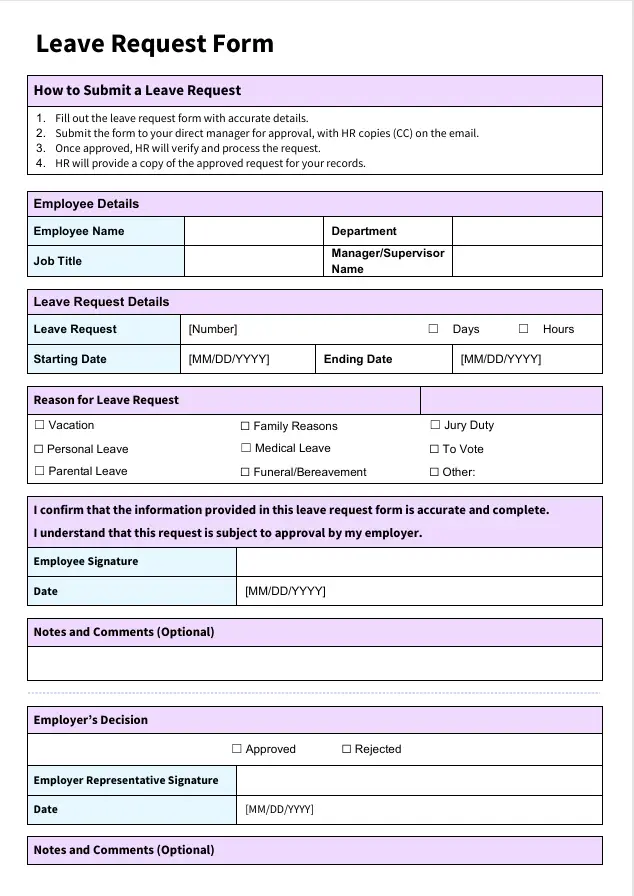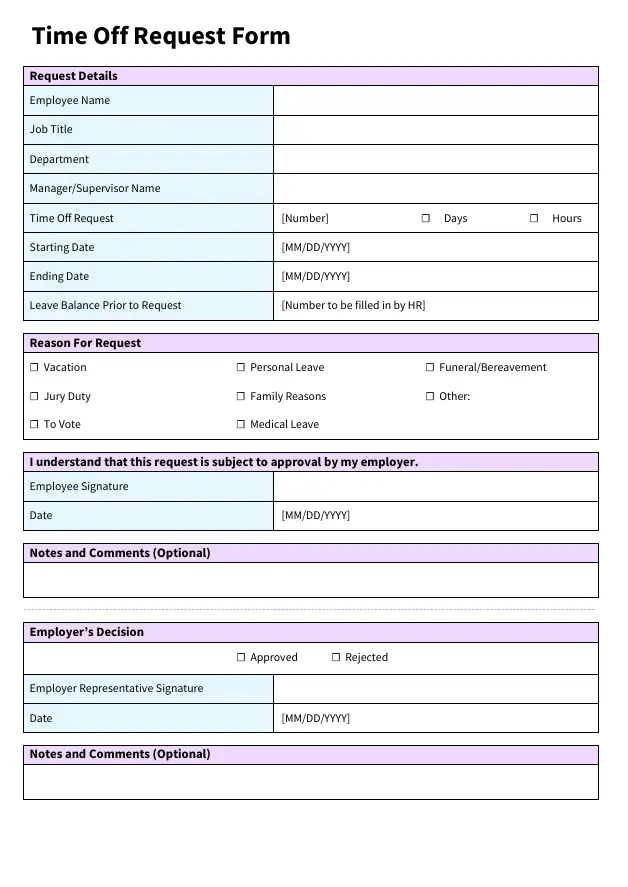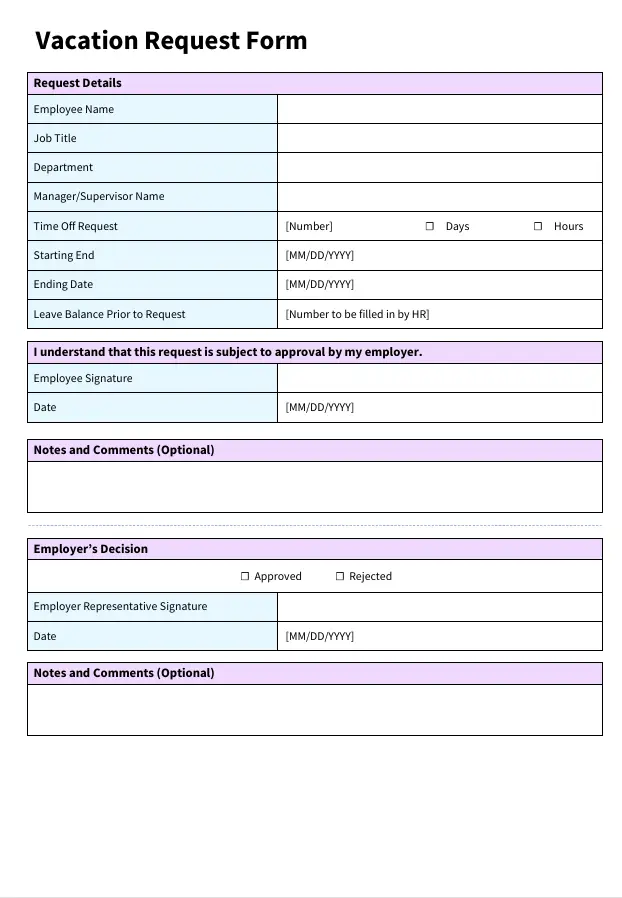Taking time off shouldn’t be complicated. Yet, many employees still struggle to ask for leave the right way. A clear time off request form can make the whole process easier for both employees and managers. It helps you record the reason, dates, and approval in one place, so nothing gets missed.
Whether you need a paid time off request form or a simple employee time off request form, using a ready-made template saves time and avoids confusion. You just fill in the details and share them for approval. That’s it.
In this blog, you’ll find easy-to-use templates that help you make time-off requests simple and organised.
What Are the 3 Types of Time Off Request Templates?
All teams handle sprint planning in their own way, and it is necessary to select the appropriate template. Here are 7 types of sprint planning templates that can be used to accomplish various tasks, from basic task breakdowns to elaborate Agile and Scrum models.
1. Leave Request Form
A leave request form is the most common and straightforward format employees use to ask for time off. This form contains such details as the employee's name, the dates for the leave, the reason for the leave, and a section for the manager to make certain that everything is clear when someone is away and for how long.
Instead of sending informal messages or emails, using a structured leave request form template keeps everything official and easy to review later. It’s easy to fill out and works well for all kinds of leave, such as casual leave leave, sick leave, or planned vacations.

Key Features:
- Employee Details: Name, department, and contact info.
- Leave Duration: Start and end dates for the time off.
- Reason for Leave: A short note on why leave is needed.
- Approval Section: Space for manager or HR approval.
- Comments Field: Optional notes or clarifications.
Best For:
Teams or organisations where employees regularly apply for short or planned leaves. It’s ideal for HR teams that want a clear and consistent request time off form format to manage all leave records in one place.
2. Time Off Request Form
A time off request form is used when employees have to take time off from work for purposes other than normal leave. A personal errand, a family matter, or a short break may be some of the reasons. This form records the exact dates, length, and type of time off needed.
It keeps communication clear between employees and managers, so there’s no mix-up about who’s available and when. Having a standard employee time off request form also makes it easier for HR to review and approve requests quickly.

Key Features:
- Personal Details: Include the employee’s name, department, and position.
- Time Off Type: Select the reason, such as personal leave, remote work, or half-day.
- Date and Duration: Specify the start and end dates of the leave.
- Manager’s Decision: Section for approval or feedback from the manager.
- Signature Area: Space for both employees and managers to confirm the request.
Best For:
Ideal for companies that manage both full-day and partial-day absences. Works best when teams need a quick and efficient way to communicate any request for time off without using e-mail or chat functions.
3. Vacation Request Form
A vacation time off request form template is made for planned holidays or long breaks. It helps employees share their vacation plans in advance so managers can plan schedules and workloads accordingly. With this form, everyone stays informed about who’s away and when, avoiding last-minute confusion.
The vacation time off request template can also track all approved leaves, which assists HR teams in managing annual leave balances. It’s a simple and reliable way to keep vacation planning smooth for both sides.

Key Features:
- Employee Information: Include basic details such as the employee’s name, role, and department.
- Vacation Dates: Clearly mention the start and end dates of the planned leave.
- Reason or Notes: Optional section to add a brief comment or reason for the time off.
- Approval Section: Space for the manager or HR to review and sign off on the request.
- Status Field: Used to indicate whether the request is pending, approved, or declined.
Best For:
Best suited for teams that plan vacations ahead of time. It can be helpful for HR departments to have all of the time off request forms in one easy place, for tracking purposes and to ensure operations go smoothly when several employees are on leave.
What Are the Pros and Cons of Time Off Request Templates?
Using a time off request form template makes managing leaves easier, but it also has a few limits. Here’s a quick look at both sides.
| Pros of Time Off Request Templates | Cons of Time Off Request Templates |
|---|---|
| Keeps all leave records organised in one place. | May need updates when company policies change. |
| Saves time for both employees and HR. | Some employees may forget to submit it on time. |
| Reduces confusion about dates and approvals. | Can feel formal for small teams. |
| Makes approvals faster and more transparent. | Manual tracking can be harder without digital tools. |
| Works well across formats like Word, PDF or Excel. | Not ideal for real time tracking or automated reminders. |
How Does Time Champ Track Employee Time Off?
Manual tracking or using sheets and templates can often lead to errors or missed updates. When requests pile up, it becomes harder to know who’s actually available. That’s where automation helps. Time Champ takes care of all this by recording automatically when workers log in and log out, so that you always have the correct attendance data without manual work.
With Time Champ’s leave management feature, managing time off becomes effortless. Employees can easily apply for leave, specify dates, and select the type of time off, all in one place. Managers receive instant notifications to review and approve requests, ensuring a smooth and transparent approval process. The system updates attendance automatically, giving managers a real-time overview of who’s on leave, who’s available, and how schedules are impacted. Everything is streamlined within one unified platform, reducing manual effort and keeping teams organised.
Conclusion
Using a time off request form keeps the leave process clear and consistent for everyone. Whether it is a leave request form, a holiday period time off request form template or a simple time off request form, having a specific form helps to eliminate confusion and save time. It makes it easier for employees to ask for time off and for managers to approve it without back-and-forth messages. Choose a template that fits your workflow and keeps things simple, organised, and stress-free.
Frequently Asked Questions
Having a time off request form is helpful in keeping the leave information in one area, which makes it easier for the manager to review and approve. The information on the form will help prevent confusion on dates, reasons, or overlapping leaves among team members.
A good time off request form should include employee's name, department, reason for leave, start and end dates, and an approval section. Keeping these fields clear makes it easier for both employees and managers to process requests without confusion.
Digital forms are faster, more accurate, and easier to manage than paper-based ones. They also reduce the risk of losing records and make it simpler to track approvals over time.
If a request is not approved, things usually either overlap with time off requests, workload and priorities of the team, or potentially a policy issue. Employees can discuss alternate dates or update their request to better fit team availability.








